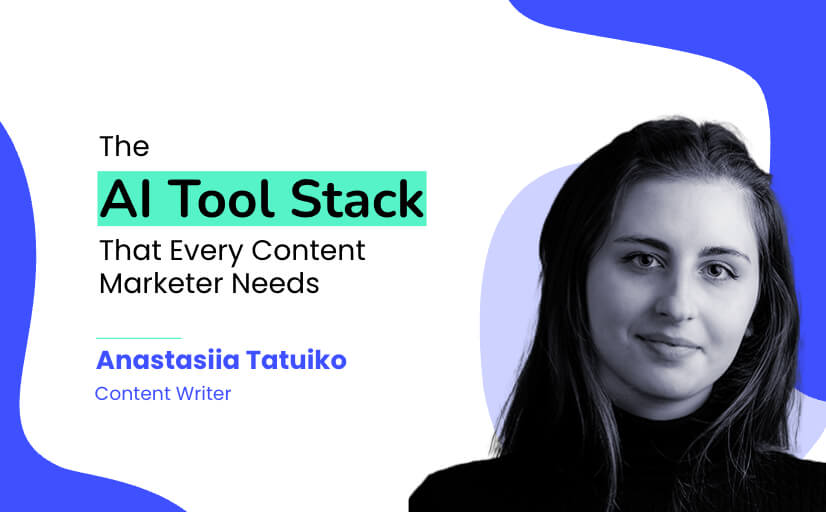Find out which AI tools every content marketer needs to integrate into their workflow to improve efficiency and quality.
The AI Tool Stack Every Content Marketer Needs
Author: Anastasiia Tatuiko, Content Writer

Every content writer has likely been told that AI is here to take their jobs. However, AI isn’t a real threat to innovative human minds– rather, it’s the content creators who have integrated AI into their tool stack.
Utilising AI tools in your content creation process means working smart and accomplishing more projects than you might have imagined. You can streamline your workflow, generate more content faster, and come up with new ideas effortlessly and with fun.
In this article, you will get acquainted with 7 AI content tools that will help keep you ahead of the game when it comes to content marketing.
Why You Should Embrace AI
Instead of listing the benefits of AI content tools, let’s look at real-life examples that may be relevant to you. This way, you can see how AI can make your content-creating life easier.
- Do More, Create Faster – As a content creator, there are nuances of your work you can delegate to an AI tool. These can include generating a ton of meta descriptions, page titles, content outlines, images, presentations, and more. AI can complete smaller tasks you would normally do manually and open up time to allow you to immerse yourself into writing.
- Stuck on a Sentence? Ask AI – Ask your AI to paraphrase or edit content that you aren’t entirely happy with. You will end up with a text that reads better and is well-phrased. Use it to your advantage and boldly “borrow” the ideas. Remember, AI isn’t capable of generating high-quality, long-form content, but it certainly can improve whatever you’ve written so far.
- Stock Photos Too Dull? Let AI Handle It – Tables and bullet points can do so much, but high-quality and life-like photos can add a nice touch to your article. You don’t have to be a blogger to recognise a stock photo that has recurred on so many pages before. AI generates unique images based on your prompts and needs. Although not perfectly, with the proper prompts, it will get it right eventually.
Building Your AI Tool Stack
Here are must-have and must-use AI tools you should be already working with if you’re a content marketer.
ChatGPT
By now, you should have heard and tried ChatGPT, so it isn’t a big surprise it is first on the list. What you may not know is how to phrase your prompt to generate readable and nonrepetitive content.
ChatGPT isn’t great with long-form content – however, it masterfully handles short-form content, especially when it comes to succinct meta descriptions, catchy headers, and well-structured article outlines.
Take this AI-generated content as an example, and let’s break down the problems.
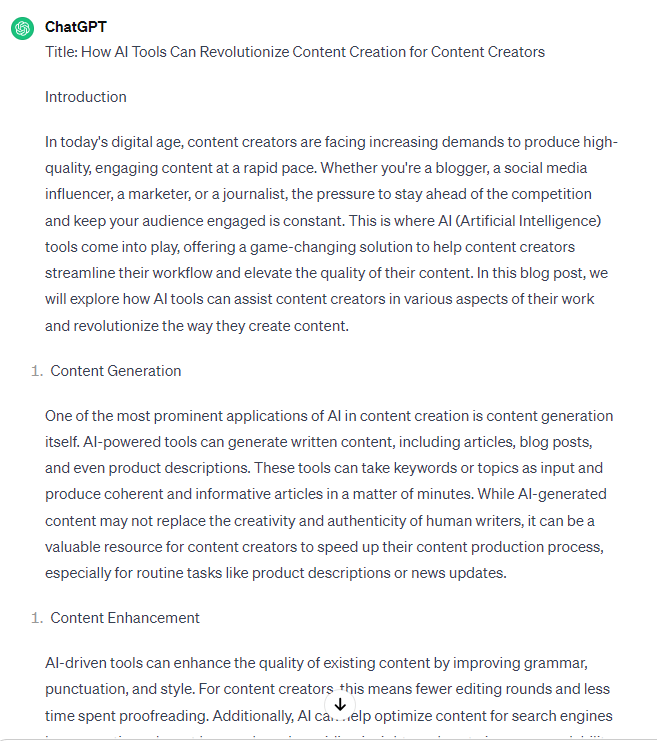
The prompt: Write a 1.5K blog post on “How AI tools can help content creators” in a professional tone of voice.
Total word count: 738
The main issues with this text are:
- Low word count
- Long paragraphs
- Typical headers
- No personality
You may say the text sounds plain and dull because of the “professional tone of voice.” What happens when ChatGPT is asked to add some jokes and to generate content with a bit more creativity?
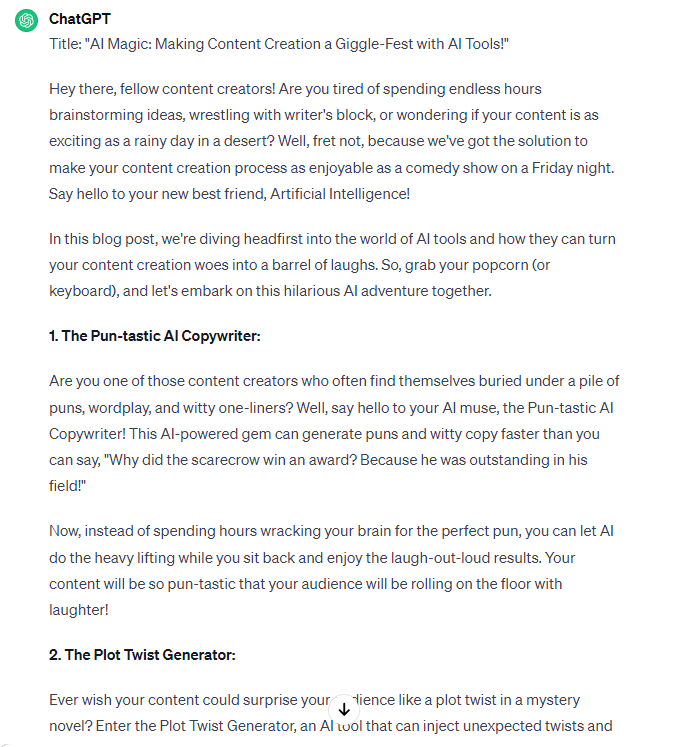
The result is “pun-tastic” AI-generated content with totally made-up information. ChatGPT takes us from one extreme to another.
This brings us to the second thing you must remember – the prompt is everything. Previous examples failed not because ChatGPT is still learning – it actually did everything as I asked – but because my prompt was too short and not descriptive enough. Work on your prompts and find out what works well for your brand. Find out more about how to use ChatGPT for content writing and SEO purposes here.
Rytr
Rytr is another AI content tool that is great for generating outlines, blog posts, cover letters, emails, product descriptions, and more. The program has a filter through which you choose a predefined tone of voice, the purpose of your content, and keywords. But is it better than ChatGPT?
To compare how Rytr competes with ChatGPT, we started with an easy task – creating a blog outline with an enthusiastic tone of voice. Unlike ChatGPT, Ryter has a list of voice tones you can use, which some may find limiting.
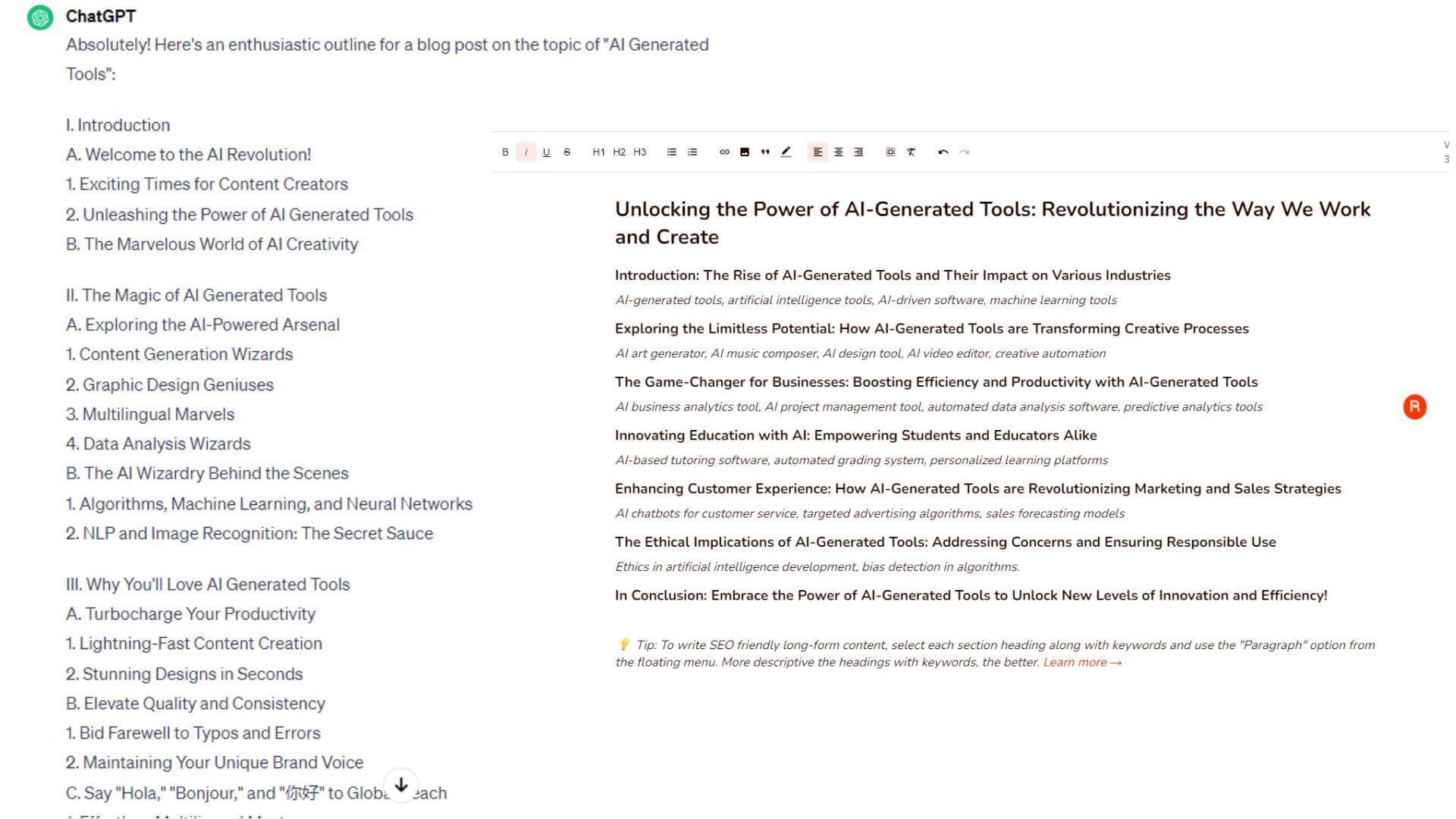
Given the main keyword, “AI generated tools,” ChatGPT (left) generated quite a long outline but succinct titles, while Rytr (right) approached the task more creatively with 7 main titles and short descriptions for each of them. One point to Rytr.
After briefly describing the topic and again choosing an enthusiastic tone of voice out of 23 available, here is the result of a blog post:
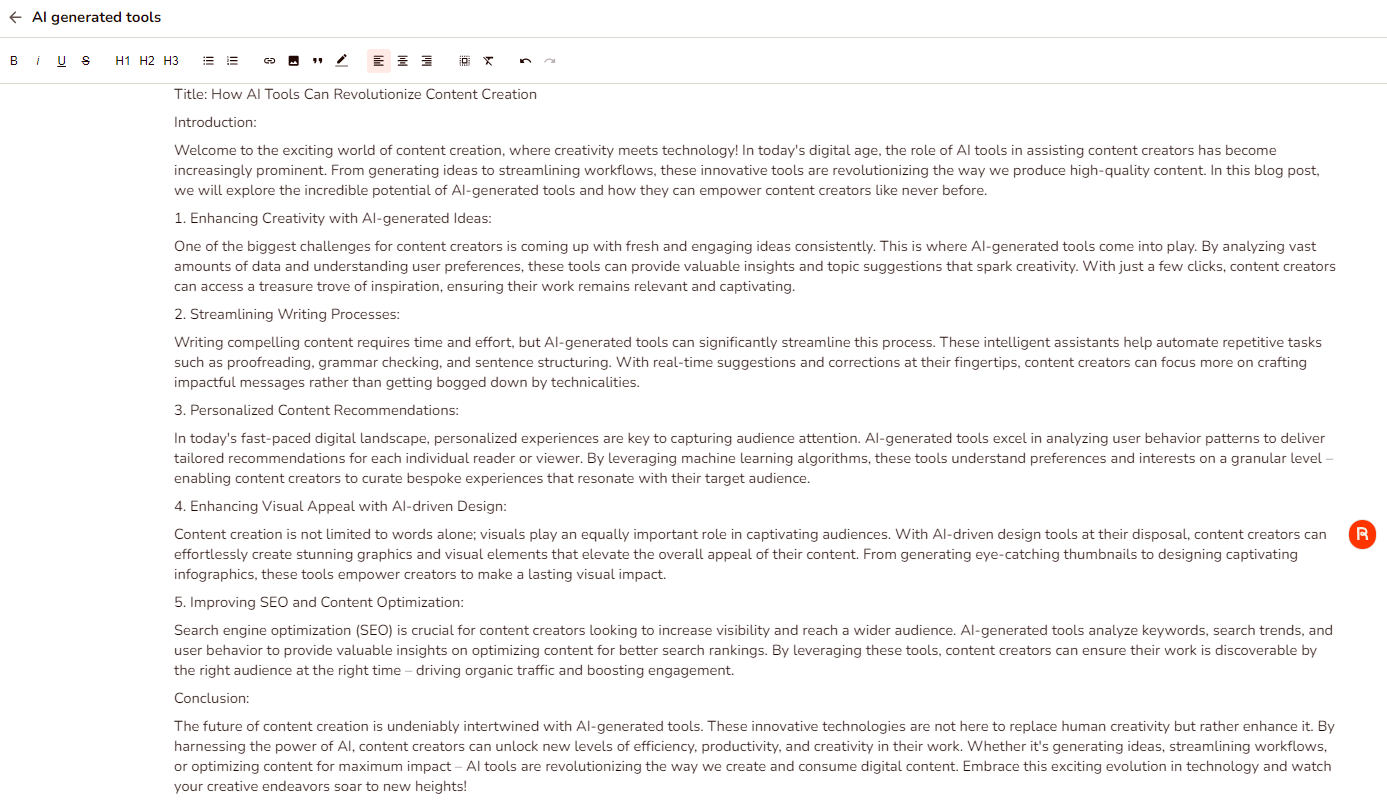
The AI-generated content is not half-bad, but it is even shorter than the one ChatGPT generated. Rytr is as good for short-content creation as ChatGPT is.
Quillbot
Quillbot is a grammar and plagiarism checker and paraphraser in more than 10 languages. The free version allows you to paraphrase multiple texts, and this is what we’ll be focusing on here. If your AI Detector flashes a red alarming light that your content is 100% not human-written, Quillbot may help you with that.
Quillbot’s personal AI Detector feature has shown that the first few paragraphs of Rytr’s generated blog are indeed AI-written.
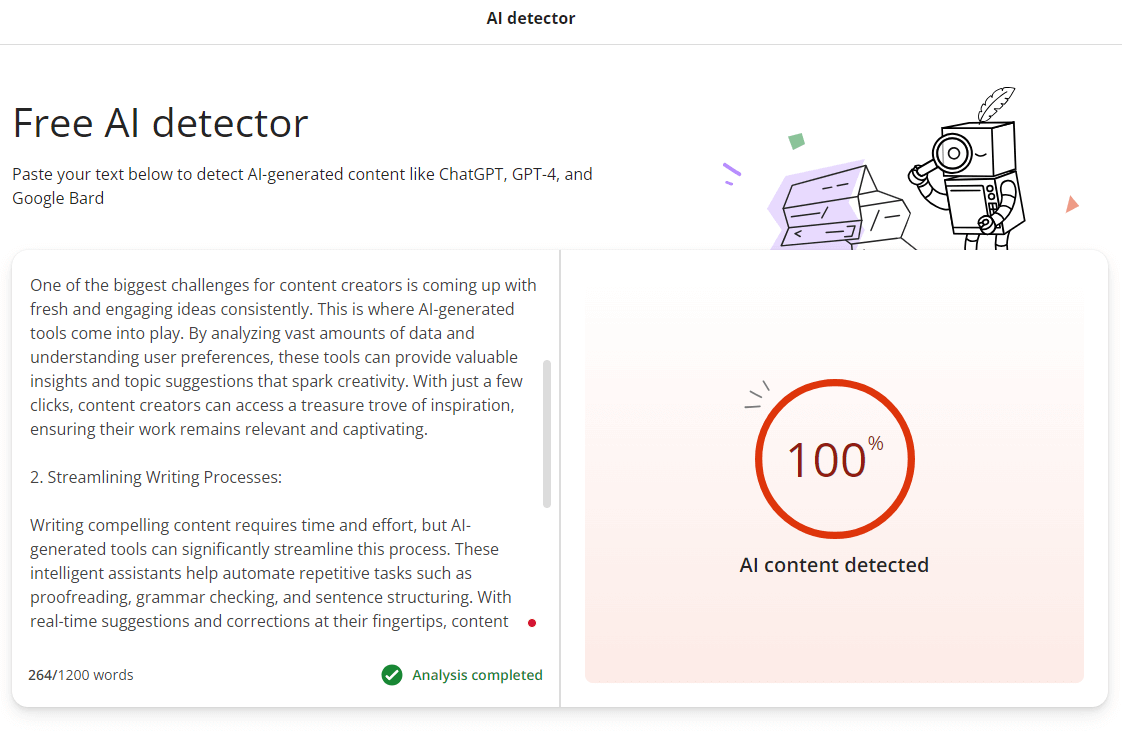
Let’s paraphrase each paragraph and see the results:
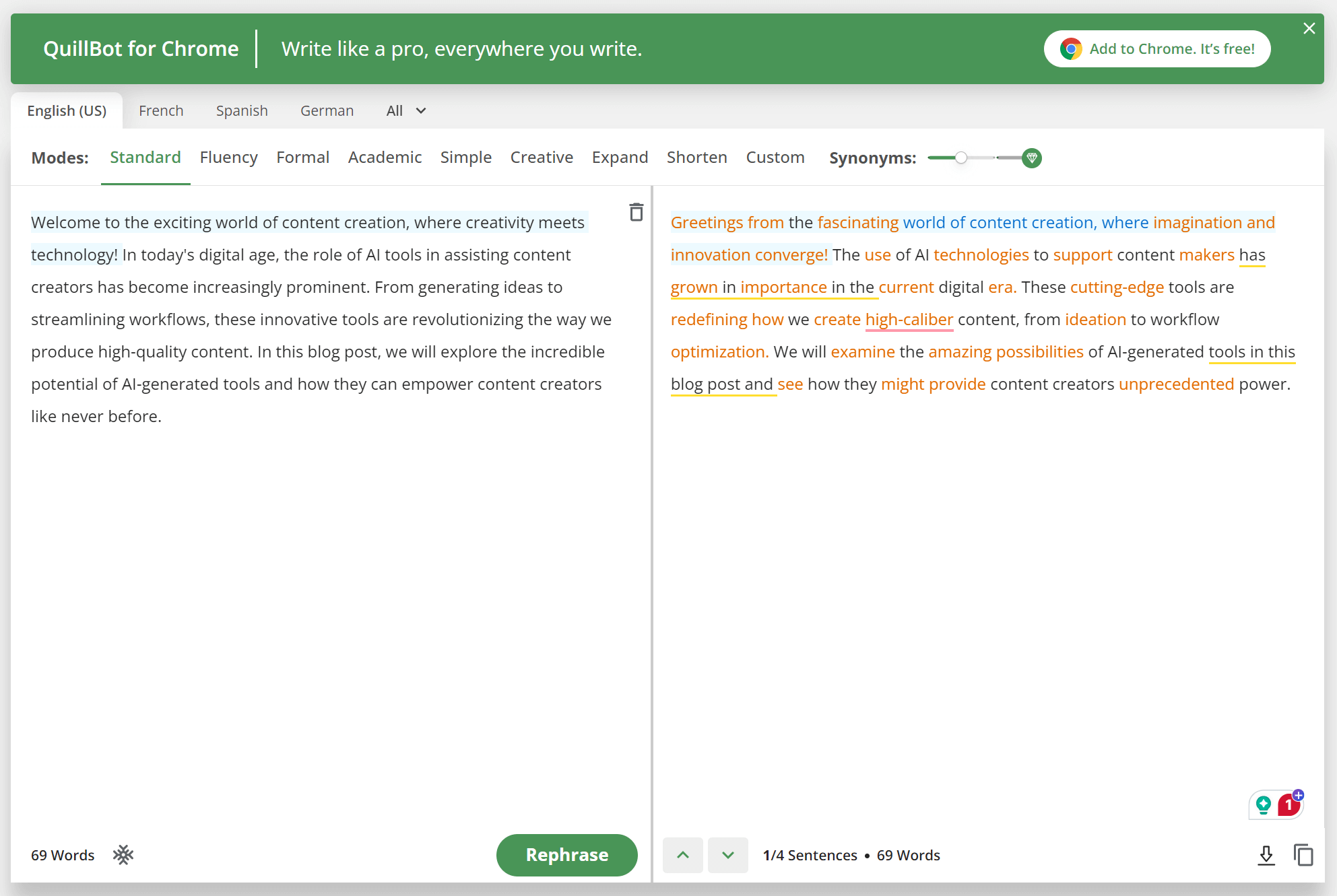
Sadly, the paraphraser lacks a human touch, but it surely made it does take the AI-generated content quality up a notch.
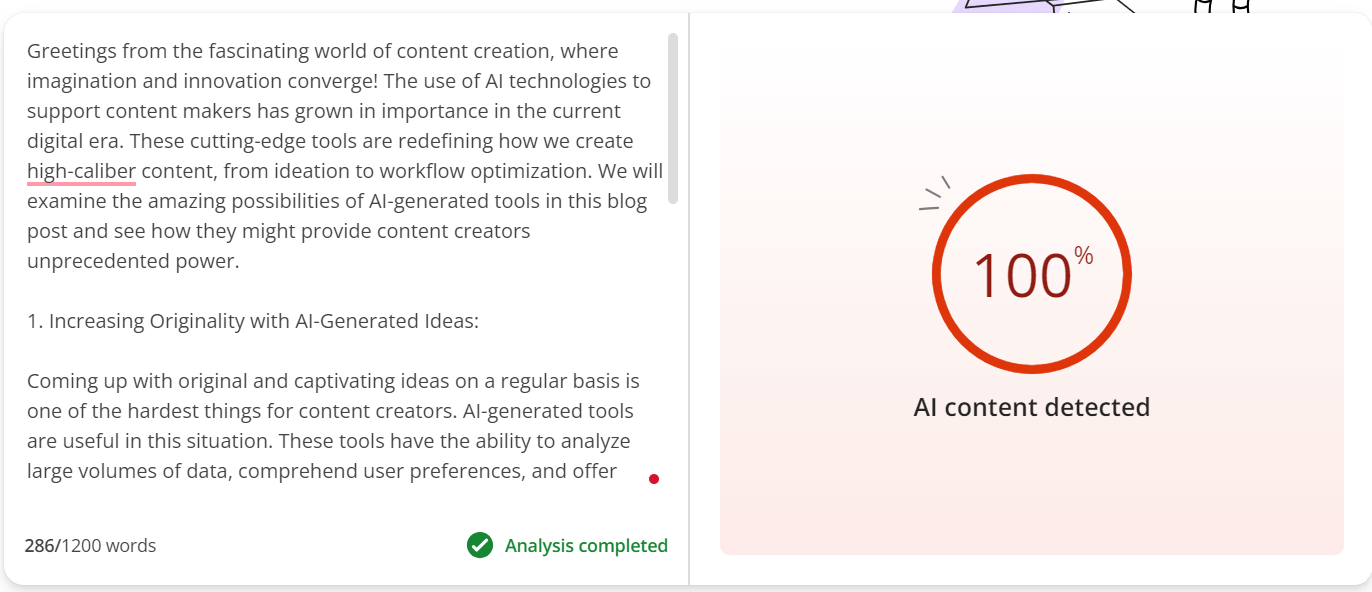
Nevertheless, your own content can be improved, especially if you play around with the different modes the program offers.

DeepL & Google Translate
Google Translate has been around since 2006, and because it’s been with us for so many years, the fact that it is powered by artificial intelligence is often overlooked.
Non-native English content creators may sometimes get stuck on a word that they know in their native language but can’t remember in English. But when Google Translate is wrong, DeepL can help!
Although Google Translate has gone a long way and is rarely wrong, it is still not very accurate when it comes to some languages. To make sure the word you are looking for is translated correctly, use the two AI tools side by side just like you would be using a few AI Detectors.
Midjourney
Midjourney is a revolutionary AI generation tool that can create unbelievable images but may also fail miserably. Some users have a love-hate relationship with Midjourney because of the photorealistic images it can produce and its mishaps when it comes to details it can’t comprehend:

The photo on the left was created using the prompt: “A single senior woman sits at the table and looks at papers.”
The photo on the right was created using: “A realistic photo of a man turning on the air conditioning.”
Both short and long prompts work well with Midjourney – it’s just it isn’t perfect (yet!) with elements like body parts (hand, especially), some pieces of technology (e.g., heating and cooling systems), equipment (e.g., single details of a bicycle), and so on.

That being said, Midjourney can generate outstanding photos and artistic imagery for all sorts of situations and it’s only going to get better.
DALL·E 2
With a paid ChatGPT account, you get access to DALL·E 2 – another image generation AI tool. Just like Midjourney, the images it produces highly depend on how you phrase your prompt.
Using the same prompts for DALL·E 2 as for ChatGPT, the results are as follows:

Based on the results, DALL·E 2 can also generate good-quality images, and if you’ve already bought a paid version of ChatGPT, then this might be a better choice for you.
FAQs About AI Content Tools
What Are the Risks of AI-Generated Content for SEO?
AI-generated content may not bring any value to the reader and may also provide false information – this is because the tool is only able to generate content based on its training data. As we’ve already established, AI content lacks that human touch, those personal human anecdotes or experiences that cannot be replicated.
Your content shouldn’t consist of a wall of text but offer information that focuses on the reader. In other words, focus on following E-E-A-T guidelines and writing content for humans as opposed to search engines.
Can Google Detect AI-Generated Content?
Google can detect AI-generated content, especially when it’s produced in a spammy manner and doesn’t add any value to the topic or has a repetitive structure and lack of nuance. However, the search engine focuses “on the quality of content, rather than how content is produced.” AI-generated content is not punished unless the primary purpose of the content is to “manipulate ranking in search results.” You can find out more about Google’s stance on AI-generated content here.
The Bottom Line
Enhancing your content creation experience becomes more enjoyable with the help of AI tools designed to inspire and accelerate your workflow. Many of the AI content tools discussed earlier offer free versions, enabling you to test them before making any commitments. Upon exploring each tool, you’ll discover its potential to elevate your creations and spark innovative ideas that may not have occurred to you initially.
Embracing the future of AI gives an opportunity to understand the workings of various algorithms and even crack the code of how to generate perfectly-former hands.
More articles
View more of our research.

Constructing An eCommerce Website for SEO
Find out how to construct an eCommerce website that is great for users and accessible for search engines.

Educating Clients on the Value of SEO: A Guide for Marketing Managers
Find out how marketing professionals can transform their clients' perception of SEO by educating them about the value that it can bring to their businesses.
